A yarn can catch my attention for many reasons. In this case, it was the name. You see, my mother is Panamanian.
Several months ago, I was working on an article about Farah Knudsen and her small-batch, breed-specific yarn company for Farm & Fiber Knits. Farah hand-selects fleeces from farmers and ranchers, mostly in her home state of Utah, and works with small local mills to turn those fleeces into yarn. During our interview, she mentioned a batch of Panama wool that was currently at the mill. I did a double take.
I hadn't heard of Panama wool before. I had to find out more. My curiosity led me down a rabbit hole which started with my copy of The Fleece & Fiber Sourcebook, by Deborah Robson and Carol Ekarius. I found a 1952 term paper in the University of Idaho archives about the origin of the breed. I even interviewed Lane Jensen, the rancher whose sheep provided the wool for this yarn, for an article which appears in the current issue of Spin Off magazine.
When Panama wool yarn appeared on the Knudsen Knits website, I ordered a couple of skeins. I'm happy to tell you all about it today.
FYI: I purchased this yarn at full retail price. The yarn links are not affiliate links. I have no business relationship with Knudsen Knits. I simply admire the work Farah Knudsen is doing to make locally grown and processed wool available to knitters in her community.
The book and magazine links are affiliate links to either Long Thread Media or bookshop.org. If you make a purchase using these links, I may earn a small commission at no additional cost to you.
First, the Specifications
This yarn is suitable for use with patterns calling for heavy worsted or aran weight yarn.
Let's Take a Closer Look
Knudsen Knits Panama is a 3-ply yarn with a firm twist. The 3-ply construction makes this yarn quite round, while the high twist makes it durable and bouncy.
The first word that comes to mind when handling this yarn is sturdy. The twist of this yarn locks the fibers together securely. I cannot break the yarn with my hands. There are no fuzzy fibers forming a halo on the surface.
While there were no knots in the two skeins I sampled, there were a few inconsistent spots where the yarn become thicker or a little slubby. There was some vegetable matter1 in the yarn, but not enough to annoy me. For me, these irregularities are a reminder that this is small batch yarn, not an industrial product.
Let's Look at a Swatch
My Stockinette stitch swatch was knit on size US 9 (5.5 mm) needles. My gauge is 16 sts and 24 rows = 4" (10 cm). While there is no gauge recommendation on the yarn label, I think this is an appropriate gauge for this yarn.
Panama was an easy yarn to knit. The yarn did not split or untwist. I could easily knit this piece, which is at the chunky end of my comfort zone2, without looking at my hands.
The fabric is firm and cohesive. There is no hint of a halo, and I can’t call it soft. But I wouldn't call it scratchy or rustic either. This is a fabric I could comfortably wear against my skin, but that might not be true for you if you are more sensitive than I am.
The swatch reveals the artisan nature of this yarn. You can see sections where the yarn was a little thicker, causing the stitches to look uneven. A close look also reveals a few flecks of vegetable matter that I probably could have picked out while knitting.
Panama is a good yarn for sweaters which will be subject to hard wear. I suspect pilling would be minimal. If you used a needle one size smaller for a slightly tighter gauge, this yarn would make terrific mittens for outdoor winter chores like shoveling snow.
The Test-Drive Hat
I wanted to give this hat both texture and color. Sticking with my size US 9 (5.5 mm) needles, I started with K1, P1 ribbing, then transitioned to a slip stitch stripe pattern. As you can see, the stitch definition is crisp. This stitch pattern creates a waffle-like texture which is amplified by this relatively chunky yarn.
This is a hat I will keep for those rare occasions when I get to watch my San Francisco Giants play at Oracle Park.
The Colors
Panama is available in the natural white of the sheep plus a limited range of colors hand-dyed by Farah Knudsen. The dyed color I sampled (Saffron) did not rub off on my hands or needles, nor did it bleed into the warm water I used for blocking. The color is intense. There is very little variation in tone throughout the skein; it's about as solid as you can get with hand-dyed color.
What You Can't See
Panama sheep have nothing to do with the country of Panama (sorry, Mom.) The Panama breed was developed in Idaho in 1912 by crossing Rambouillet rams with Lincon Longwool ewes. Three lambs were exhibited at the 1915 Panama-Pacific Exposition in San Francisco, and the breed was dubbed the Panama.
The Panama sheep who grow the wool for this yarn are raised by Eph Jensen Livestock, a fourth-generation family ranch in Utah. The Jensen family have been breeding Panama sheep since the mid-1970s. The Panama is relatively small for Western range sheep. The Jensens find their strong maternal instincts and consistent fleece quality well suited to their ranching practices.
Panama is classified as a "medium wool". The fleece is nearly always white and the staple length with annual shearing is 3–5". The fiber diameter averages 25–30 microns (as a comparison, "fine wools" such as Cormo average 17–23 microns, while human hair is 50–180 microns.)
Panama sheep never spread much beyond Idaho, Montana, and Utah. There is no active breed registry, so no one knows how many Panama sheep currently graze the Western range of the United States. Many have been crossbred with other range sheep, such as the Columbia. Most Panama wool is blended with other range wool and sold through large wool pools. Because of this, it is difficult to find breed-specific Panama yarn. It is due to the efforts of dedicated breeders like Lane Jensen and yarn makers like Farah Knudsen that we can knit with and appreciate the qualities of this all-American wool.
The Bottom Line
If you, like me, enjoy exploring the wide range of wools produced by different sheep breeds, don't miss this opportunity to work with a truly rare yarn. Support artisan yarn makers like Knudsen Knits by purchasing a couple of skeins, then make yourself a hat or pair of mittens that will embody a great story while doing the hard work of keeping you warm.
Some Things That Caught My Eye…
If the comments about vegetable matter in this week's yarn review interested you, I wrote an article about how vegetable matter is removed from wool for Farm & Fiber Knits. You do need a subscription to read this piece.
I'm not a knitter of holiday gifts, but I enjoyed reading Cate Gander's thoughts on the topic.
What makes the distinctive tinkling sound of the Sugar Plum Fairy's dance music? The celesta! See and hear this delightful instrument in this article from the New York Times.
As always, thank you for joining me on my yarn-y explorations. The next few weeks will probably be more books than yarn. I just received a batch of yarn for a new design commission, which I won’t be able to share with you until the designs are published. But there is another yarn review (or two!) in the pipeline, and I’m looking forward to sharing some terrific books I’ve been reading lately.
What is keeping your hands and mind engaged these days? Have your holidays been merry and bright so far? I’d love to hear about it in the comments.
Vegetable matter (aka: VM) is bits of straw, seeds, dried grasses, and other plant matter. All wool is contaminated with VM when it comes off the sheep, no matter how well the flock is cared for .
My happy place when it comes to gauge is somewhere between 20 and 28 sts to the inch. That translates to sport or DK weight yarn. Anything requiring needles size US 10 (6 mm) or larger feels awkward in my hands.


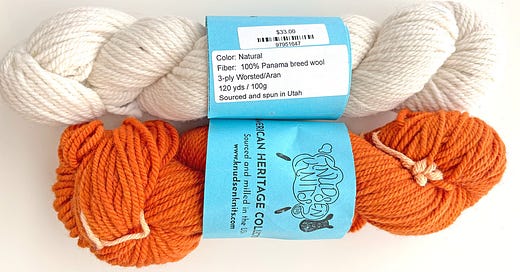




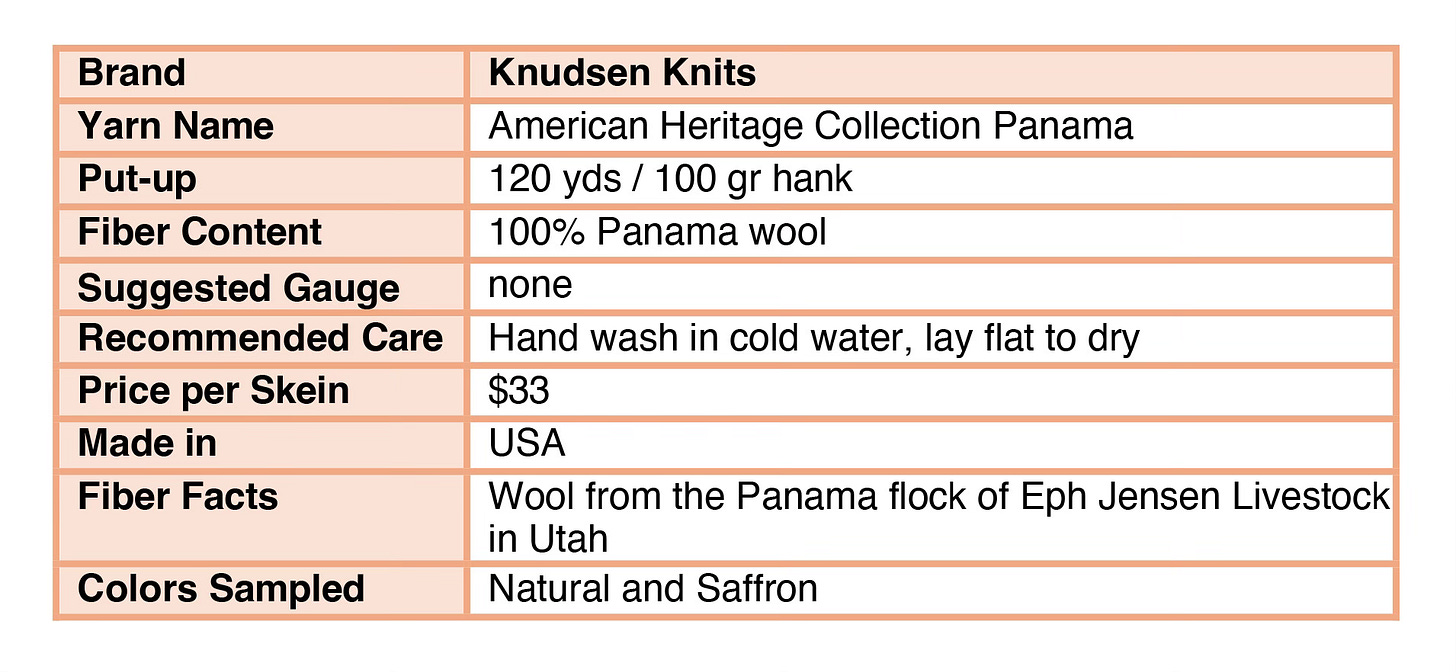
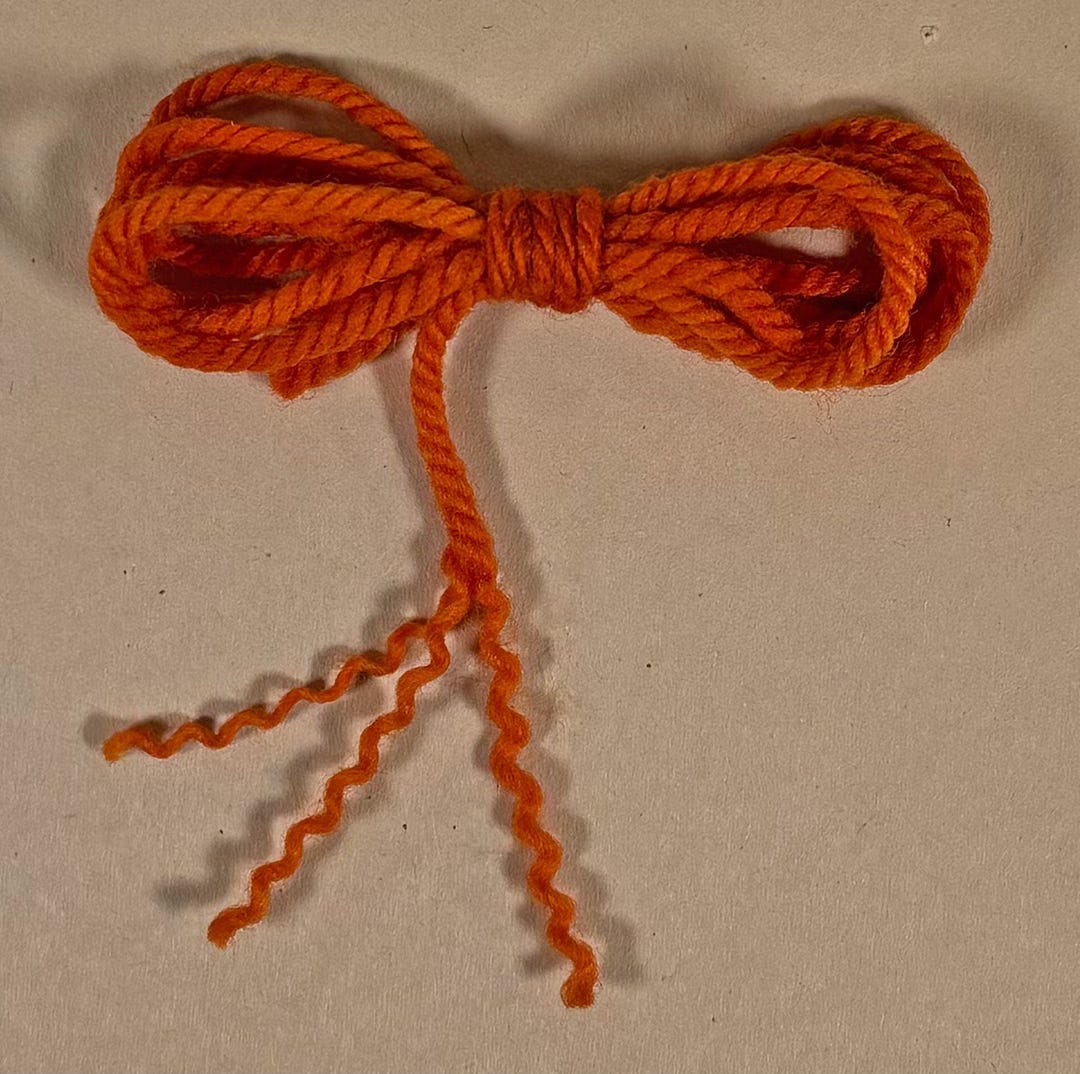
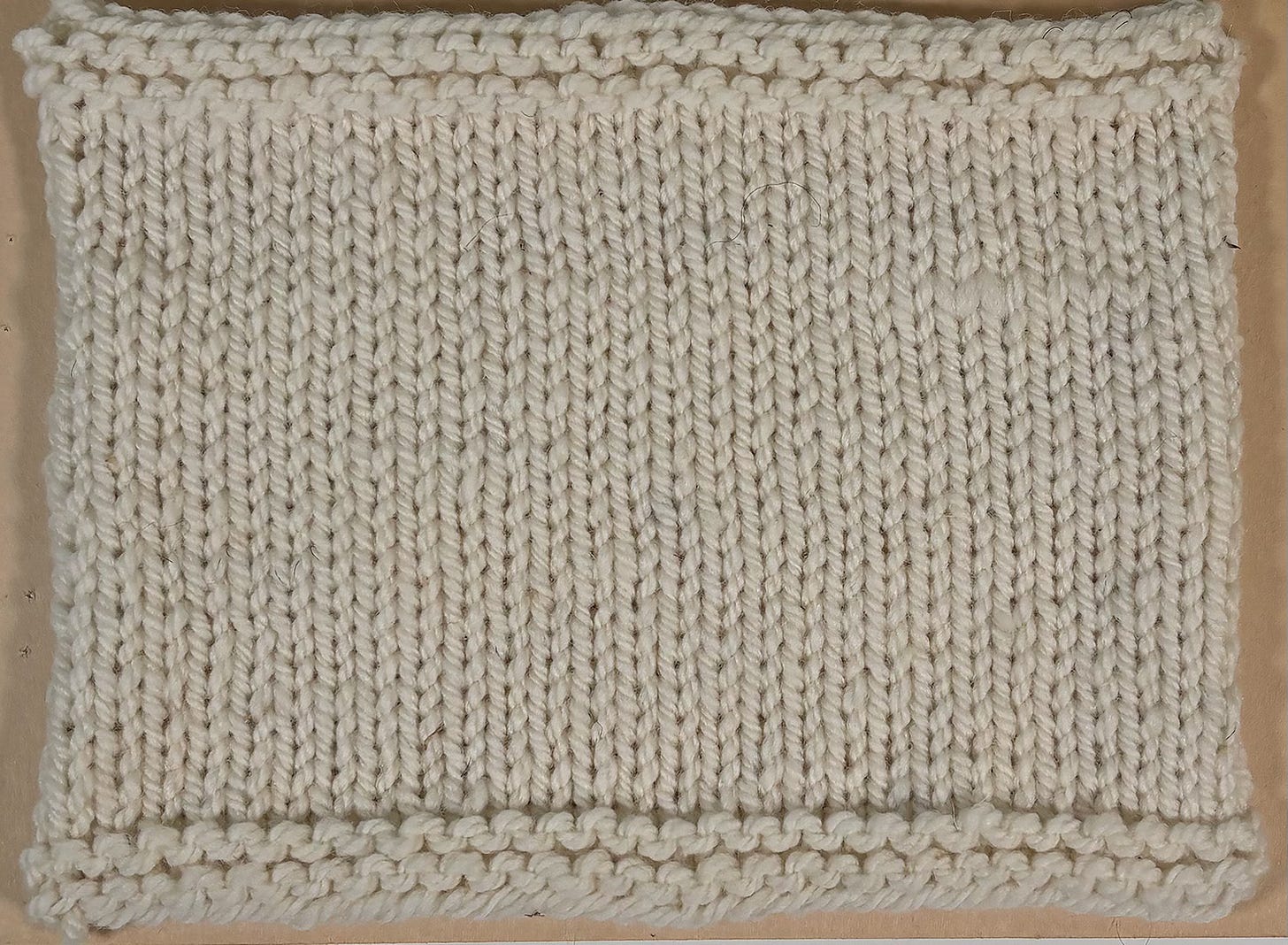
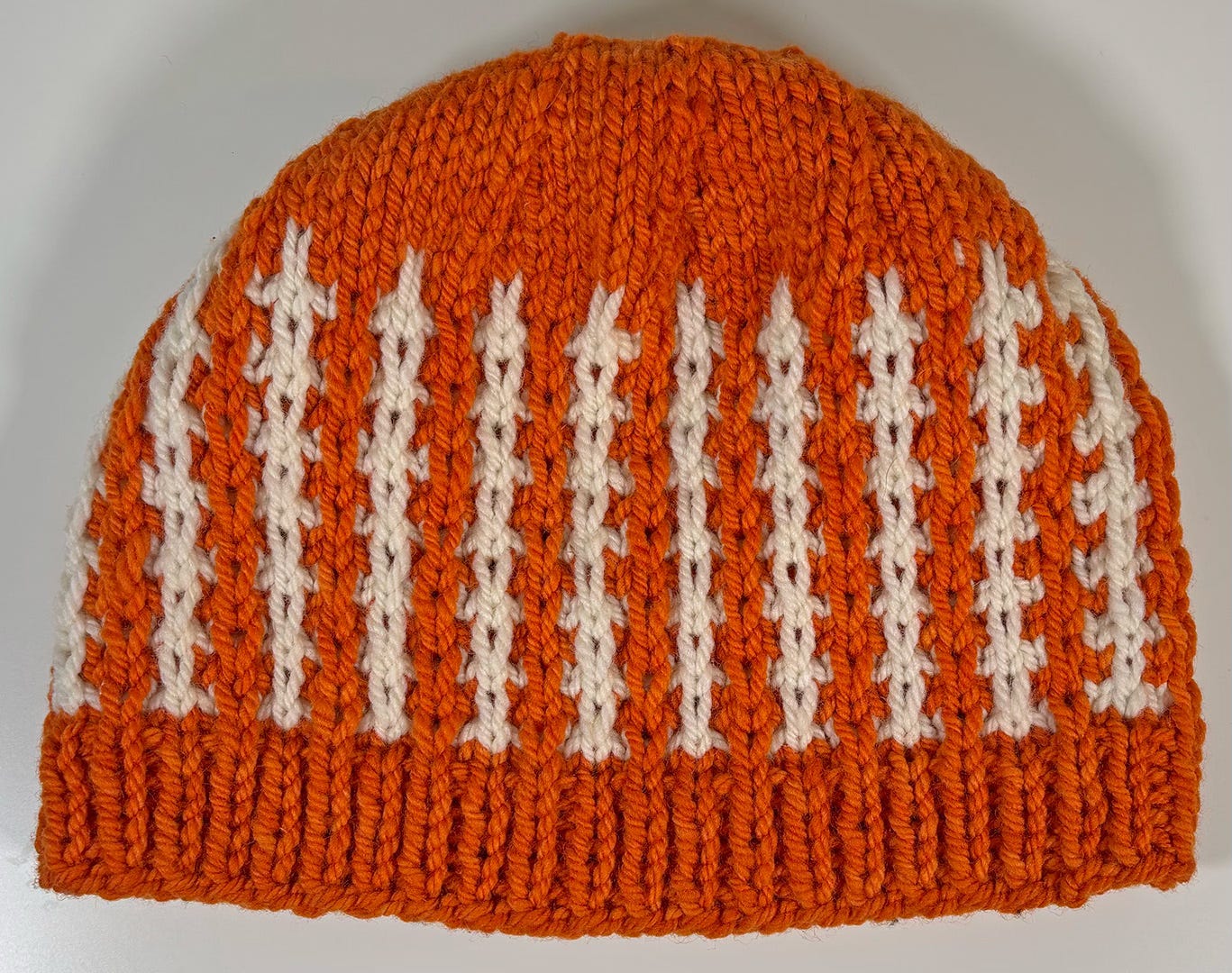
Well... I also did a double take on the appellation for the yarn. Panama, being a happy tropical country (mostly rain forest, a few plains, and pine forest in the north volcanic region bordering with Costa Rica) grows some sheep for food and milk but not for the wool. Knitting is not a primary craft there. That is why you had to teach yourself to do it, my dear. It was not, and still isn't in my talent box. But your description of the yarn brought up a few giggles. It sounds as if you were describing your mother's character and personality: serviceable, sturdy, reliable; but definitely not soft enough for gentle baby blankets or booties. One big plus: the skein hue unchanged, consistent throughout.
My mother sewed most of our clothes. She didn't knit either, but practiced every other fiber art and craft with expertise. I remember owning only a shell and sweater set mail ordered from the Sears catalog. Light weight. Pale yellow. Suitable to wear on foggy mornings during a stay at a mountain hotel in Cerro Punta's volcanic region, where coffee plantations cover the mountain side and a cold morning drizzle welcomes you to the skirt of the Barú Volcano. But, as usual, I digress... At a certain age one tends to reach for every thought before it vanishes in the profuse jumble of memory.
By the way, Panama hats, so light, white, finely woven with jipijapa straw, and "only in my dreams" expensive, are made in Ecuador. Panama hats worn by Panamanian men and women, are woven with a variety of straws and decorated with black rows of dyed fibers. They are functional, take well to the calid climate. Like I said... digressing.
Sandi, I really appreciate how you put a spotlight on locally produced wool and yarn, especially small batches. There’s much you’ve described about the yarn that makes me want to get a couple of skeins (I love the saffron color). I think size 9 needles might be my limit. Sometime ago I knitted something with size 10 or 11 needles … goodness, I can’t even remember what I knitted, but I do remember how my hands hurt from wielding the large needles. I thought it would have been easier on my hands, but it wasn’t.